| Home |
| Acknowledgments |
| Conventions |
| Glossary |
| Maps |
| References |
| Links |
| Articles |
| Thumbnails |
| Species
list |
| Family |
| Next
species |
Additional Photos

translucent

intermediate

side
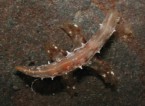
underside
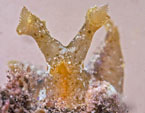
front
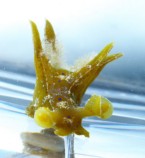
gills

yellow lines
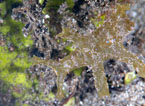
spotted
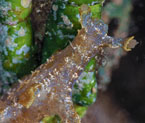
pale ocelli

ocelli detail
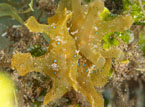
mating

with eggs
_______________
GALLERY

Scyllae sp. #1
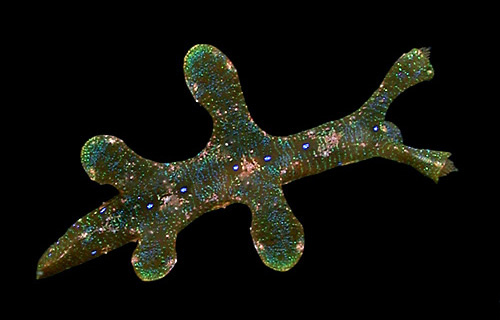
| Maximum size: 24 mm. Identification: This species is elongate with four very large dorsal lobes. The margins of the lobes may be nearly smooth or have a few short, thorn-like projections. On close inspection short, transparent gills can be seen on the notum. There are also a few small papillae on the sides of the body. There are low crests on the posterior edges of the rhinophore sheaths as well as on the mid-dorsum posterior to the lobes. There are two color forms (with some intergrading). In one, the background color is a nearly opaque olive green and the entire body is covered with irregular lines of iridescent blue-green flecks. In the other, the background color is translucent-cream, the iridescent flecks are absent or nearly absent and the margins are dusted with brown. (Note 1) A row of blue and gold ocelli runs down the center of the notum and additional rows run down each side of the body in both forms. (Note 2) Also, there are evenly spaced patches of cream flecks or short dendritic lines on the midline of the notum, on the sides of the body and on the lateral edges of the lobes. Occasionally, cream lines encroaching into the gold rings of the ocelli may appear bright yellow. Rarely, there may be evenly spaced brown spots on the body. The edges of the rhinophoral sheaths are smooth. Natural history: Scyllae sp. #1 is a moderately common animal that can be found in Halimeda kanaloana beds at depths of 5-10 m (16-38 ft). Occasionally, it occurs in association with other species of Halimeda in rocky habitats. It can swim by flexing its body laterally, if disturbed, and probably lays a kinked, white egg mass. Distribution: Big Island, Maui, Molokai and Oahu: also known from Papua New Guinea and Japan. Taxonomic notes: This species was first recorded in Hawaii from Black Rock, Maui by CP on Oct. 16, 1994. It's possible that it may ultimately be placed in the genus Crosslandia rather than Scyllae. However, Gustav Paulay (pers. com.) found a similar population from French Polynesia to be in Scyllae based on DNA evidence. That makes it more likely that the Hawaiian population is also in that genus. Photo: CP: green; 9.5 mm: Makena Landing, Maui; Aug. 2, 2002. Observations and comments: Note 1: At first glance, the extremes of these color forms look like they might be different species. However, the body form, other elements of the color pattern and the habitat are the same. Also, there appears to be some intergrading. To a human eye, the two forms seem to match the colors of different groups of brown algae (Dictyota and Sargassum?). Perhaps, the polymorphism provides better camouflage for the species? On March 15, 2009 we observed green and translucent animals copulating in a dish providing further support for lumping. Note 2: The blue and gold ocelli are virtually identical to those found in the sea hares Stylocheilus striatus and Phycophila euchlora. Since those species are known to concentrate toxins from the cyanobacteria they eat, perhaps Scyllae sp. #1 is mimicking their aposematic coloration? |
| Thumbnails |
Species
list |
Family | Next species | Top |